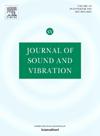A numerical study on sound radiation from circular duct with cold flow
IF 4.3
2区 工程技术
Q1 ACOUSTICS
引用次数: 0
Abstract
The characteristics of sound radiation from the end of duct can be described by the reflection coefficient and end correction, which may be influenced by the flow velocity of medium and the wall thickness of duct. In this study, an approach based on solving the two-dimensional (2-D) axisymmetric frequency domain linearized Navier-Stokes equations (LNSEs) is proposed to determine the reflection coefficient and end correction of circular duct with clod flow. The numerical predictions are compared with theoretical results and published measurements, and good agreements are observed which verifies the accuracy of the present approach. Furthermore, the influences of flow velocity, velocity profile and wall thickness on sound radiation are examined numerically. The results indicate that in the presence of flow, the magnitude of reflection coefficient exceeds unity and the value of end correction at low Helmholtz number ka is much lower than that in the absence of flow. The numerical predictions for artificially constructed infinitely thin shear layer demonstrate that the velocity profile in jet affects the reflection coefficient and lowers the value of end correction. Numerical simulations of circular ducts with varying wall thicknesses and termination geometries reveal that the limit value of end correction as converges to a common constant, provided the terminations preserve the characteristics of shear layer at the duct lip. Finally, expressions of reflection coefficient and end correction are presented by using the piecewise polynomial fitting method based on the numerical predictions.
冷流动圆形管道声辐射的数值研究
管道末端声辐射特性可以用反射系数和端部修正量来描述,而端部反射系数和端部修正量可能受介质流速和管道壁厚的影响。本文提出了一种基于求解二维轴对称频域线性化Navier-Stokes方程(LNSEs)的方法来确定含冷流圆形管道的反射系数和端部修正。将数值预测结果与理论结果和已发表的测量结果进行了比较,结果吻合较好,验证了本文方法的准确性。此外,数值分析了流速、速度分布和壁厚对声辐射的影响。结果表明,有气流存在时,反射系数的大小大于1,低亥姆霍兹数ka处的端部校正值远低于无气流存在时。对人工构造的无限薄剪切层的数值预测表明,射流的速度分布影响反射系数,降低了末端校正值。对不同壁厚和端接几何形状的圆形管道的数值模拟表明,在端接保持管道边缘剪切层特征的情况下,ka→0时端接修正极限值收敛于一个公共常数。最后,在数值预测的基础上,采用分段多项式拟合的方法给出了反射系数的表达式和末端校正。
本文章由计算机程序翻译,如有差异,请以英文原文为准。
求助全文
约1分钟内获得全文
求助全文
来源期刊

Journal of Sound and Vibration
工程技术-工程:机械
CiteScore
9.10
自引率
10.60%
发文量
551
审稿时长
69 days
期刊介绍:
The Journal of Sound and Vibration (JSV) is an independent journal devoted to the prompt publication of original papers, both theoretical and experimental, that provide new information on any aspect of sound or vibration. There is an emphasis on fundamental work that has potential for practical application.
JSV was founded and operates on the premise that the subject of sound and vibration requires a journal that publishes papers of a high technical standard across the various subdisciplines, thus facilitating awareness of techniques and discoveries in one area that may be applicable in others.
 求助内容:
求助内容: 应助结果提醒方式:
应助结果提醒方式:


